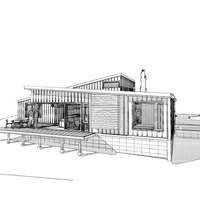
Rebecca Ford
I am a multi-disciplinary scholar whose research focuses on energy challenges and transitions for a sustainable future, the role of different agents in creating change, and the implications and opportunities for new business models, existing and new infrastructure, and shifts in societal energy culture. I am interested in how people interact with energy systems, and how social science and technological insights can be co-developed to better inform policy related to resource efficiency, carbon emissions, energy development and resilience. I recently served as Deputy Director of the Centre for Sustainability at the University of Otago, New Zealand, but returned to the UK to manage the University of Oxford's seminal research programme on integrating renewable energy.
I was awarded a DPhil in Engineering from the University of Oxford in 2010, and since completing my studies I have broadened my knowledge and extended my scope of research through subsequent academic appointments across three different divisions (commerce, science, and humanities) as well as through collaborative work with researchers from a range of disciplines both within New Zealand and internationally. Both the skills I honed in my engineering training, as well as those acquired in subsequent academic positions – including expertise in research design, development, evaluation, and management – have proved extremely valuable for planning research programmes and managing large multi-disciplinary teams.
I am highly motivated and committed to continuing research excellence, both through further developing my own research agenda, as well as convening and leading multi-disciplinary research teams capable of tackling some of our most pressing issues around energy and the environment.
Phone: +44 (0) 7429 621 611
Address: Lower Carbon Futures Group
Environmental Change Institute
Oxford University Centre for the Environment
South Parks Road
Oxford, OX1 3QY
I was awarded a DPhil in Engineering from the University of Oxford in 2010, and since completing my studies I have broadened my knowledge and extended my scope of research through subsequent academic appointments across three different divisions (commerce, science, and humanities) as well as through collaborative work with researchers from a range of disciplines both within New Zealand and internationally. Both the skills I honed in my engineering training, as well as those acquired in subsequent academic positions – including expertise in research design, development, evaluation, and management – have proved extremely valuable for planning research programmes and managing large multi-disciplinary teams.
I am highly motivated and committed to continuing research excellence, both through further developing my own research agenda, as well as convening and leading multi-disciplinary research teams capable of tackling some of our most pressing issues around energy and the environment.
Phone: +44 (0) 7429 621 611
Address: Lower Carbon Futures Group
Environmental Change Institute
Oxford University Centre for the Environment
South Parks Road
Oxford, OX1 3QY
less
Related Authors
Barry Barton
University of Waikato
Miranda Mirosa
University of Otago
Philippa L Howden-Chapman
University of Otago
Nigel Isaacs
Victoria University of Wellington
InterestsView All (6)






Uploads
Smart Grid by Rebecca Ford
1. What are the key functionalities and characteristics of Home Energy Management?
2. What are the key HEM products in the market, and how do you differentiate them?
3. What is current knowledge on energy savings and adoption potential for HEMS?
4. What are some key considerations for the future of HEMS, and what is the utility’s role?
In Chapter 2 the methods used to answer these research questions are discussed. In Chapter 3 the functionalities and characteristics of HEM technologies are discussed, and Chapter 4 outlines actual HEM products on the market and describes them in terms of 11 primary product categories. Chapter 5 presents secondary analysis of the savings potential of HEM technologies, and Chapter 6 addresses what is known and not known regarding near-term adoption potential of HEMS. Chapter 7 provides conclusions and recommendations regarding the uptake and impact of HEMS in California.
As HEM technologies become increasingly ubiquitous, with a growing capacity to leverage personalized energy information, there is an urgency to ensure that they are utilized to their full potential. As a whole, this report aims to extend what is known about HEMS and to make suggestions for future research.
While the current installed PV capacity per capita is still relatively low compared to some other countries3 (most likely due to the subsidies through attractive feed-in tariffs), the rate of uptake is of great interest given the absence of Government incentives for small-scale PV installations, along with the relatively high cost to implement4. It is important to understand the drivers of PV uptake (i.e. the reasons for the rapid increase in PV installations), and whether PV is likely to remain niche or become even more widespread.
To investigate these issues we have undertaken three separate research streams. We have carried out interviews5 with people who have already purchased (or who have a strong interest to purchase) PV systems both nationally (20 people) and within Blueskin Bay (18 people), a small region of the country with relatively high interest in PV. We have run an online questionnaire and choice modelling experiment6 with 2000 people (1000 of whom we questioned about PV), and we have responses to a national household energy survey of 2700 households around New Zealand. This report draws from all three studies to provide an update of our high-level findings to date. This is an early-stage report and further detailed analysis and reporting will follow.
energy initiatives.
• Analysis of the interviews was aided by two theories – Rogers’ model of technology adoption, and the Energy Cultures Framework, which describes an individuals’ “energy culture” according to their material culture (i.e. the physical things they have or own), their practices (i.e. what they do with their energy related technologies) and their norms (i.e. what their think about these energy related technologies and issues).
• The ‘energy culture’ displayed by interviewees typically had the following characteristics:
- Material culture – home ownership, building and site suited to PV
- Practices – already use energy carefully, sustainable living, energy literacy, actively seeking information on PV, and (for some) technological competence
- Norms – support for solar energy, desire for partial or full independence from the electricity grid, desire for greater financial control, lack of trust in power companies, confidence in the technology, environmental concern, perceived long-term financial benefits of PV
• The interviewees fell into two main clusters in how they sought information about PV.
- ‘Hunters’ actively sought technical information from a wide variety of external sources
- ‘Gatherers’ tended to rely on ‘hunters’ and other local sources for their information.
• External influences that were driving interest in PV included: the improving affordability of PV units, the rising cost of electricity, the cost of grid connection for new builds, increasing visibility of PV, information sharing within community networks, availability of tradespeople with skills in PV installation, and overseas experience in seeing PV more widely used. Influences that related specifically to the activities of the Blueskin Resilient Communities Trust (BRCT) included: facilitating supplier/installer relationships, providing an information source about PV, building energy literacy, and helping develop technical skills.
• The main barrier to uptake was the upfront cost of investing in PV. A few mentioned the lack of financial incentives (e.g. subsidies) and the speed of technological development and dropping prices, meaning they were unsure if they should wait a bit longer to invest.
• Motivations for adoption included perceived financial control and long-term benefits; enabling a degree of independence from power companies and rising electricity prices; interest in the technology for its own sake; and environmental concern.
• A key finding of the research was that the activities of the BRCT, together with other initiatives by community members, initiated or supported enablers that reduce the barriers to uptake. These included collaboration to reduce the costs of purchase and installation, provision of information and advice, building energy literacy, enhancing technological competence, and support from social networks.
Energy by Rebecca Ford
Most energy efficiency evaluations use changes in the amount of energy consumed (measured in kWh) as the dependent variable for determining effectiveness. Although this is an ideal measure of
whether energy efficiency interventions work, additional information could add significantly to our understanding about how and for whom they work. Recent efforts have been made to include such information and more and more studies are now collecting self-reported data from participants in order to better understand how and for whom behaviour-based energy interventions work.
However, widespread agreement on what data to collect and how to collect it is still lacking. Such standardisation is common in related fields such as education and psychology, but has yet to take hold in energy programme evaluation. The development of consistent, validated measures would improve our overall ability to account for variation in treatment effects and improve programme functioning and delivery.
As such, the current report presents a methodological review of behaviour-based energy intervention studies in the customer feedback and residential building retrofit areas, which were
conducted over the past 10 years to determine what data has been collected and how it has been collected. This review will form the basis of further work undertaken by the study authors and for
Subtask 9 of the IEA DSM Task 24 extension (Phase II – see www.ieadsm.org/task/task-24-phase-2/).
The work presented here suggests that future research should evaluate programmes using standardised measures across a range of key variables. The use of standard measures would
enable cross-comparisons to be made across different studies, and the incorporation of questions about context, behaviours, attitudes, knowledge, and user experience would provide researchers with insights into a richer understanding of how and for whom different behaviour-based interventions work best. Ultimately, this should result in more streamlined and effective
programmes that are targeted appropriately for different audiences.
In addition, studies would do well to make better use of mixed methods for data collection. Only 26 of the 85 studies reviewed here used interviews to collect data, with 9 studies running focus
groups. This type of data collection allows for triangulation, which can be helpful when trying to get deeper insights into the holistic impacts of behaviour-based energy interventions.
Finally, we recommend that study authors provide better transparency in the methods they use. With only 4 of the 85 studies publishing their actual evaluation instrument, it is not possible for researchers to refer to and build upon instruments that have already been developed. Creating and sharing validated data collection instruments would facilitate a consistency of measurement that could be implemented across the countless additional studies expected to be conducted in the coming years. Such consistency an improve and aggregate our overall knowledge across studies.
The analysis of the Independent Completion Review (ICR), Business Case Study (Annex 1), and the Survey Data Overview (Annex 3) indicate that the Lighting Vanuatu project has been successful in enabling the uptake and awareness of portable solar lighting products. These reports highlight that the transition from kerosene lamps to solar throughout the islands of Vanuatu was both clear and ubiquitous. When framed at this descriptive level, the project certainly presents a good news story for renewable energy.
The rapid transformation from a non-renewable to a renewable source of lighting within a 2 to 3 year period runs counter to many of the discussions in developed countries who struggle to disrupt the locked-in energy systems that sustain and maintain a reliance on fossil fuels. Considered alongside the slow and politically infused renewable energy debates in the developed country context, Vanuatu’s rapid adoption of portable solar lighting is precisely the kind of transitional story that many communities could only dream of achieving. However, the successful or unsuccessful acquisition and diffusion of a particular piece of technology – portable solar lamps – is only part of the story.
The initial aim of the Independent Completion Review (ICR) was to identify the degree of adoption and contribution made by Lighting Vanuatu, any geographic, social or cultural trends evident in adoption patterns, any economic or social benefits, specific changes in the lighting technology used by households, changes in household practices associated with any shift in technology, and changes in householders’ perceived needs and aspirations with regard to lighting. While this descriptive analysis is essential for evaluating the success of the programme within its own terms (i.e. the ICR), the broader cultural, economic and political implications of this technological diffusion have yet to be addressed. The purpose of Annex 2, therefore, is to develop the Lighting Vanuatu story further by offering a more nuanced interpretation of the transition from kerosene to portable solar lights in rural Vanuatu communities; our emphasis and focus is different to that of the ICR, but complements and enhances the understanding of Lighting Vanuatu as an aid project.
We begin by outlining the methodology used to gather and interpret the information that informs this report. We then draw on the Energy Cultures Framework (Stephenson et al., 2010) as an organising structure for describing Vanuatu’s prevailing energy culture. Next, we address four key debates to emerge from the fieldwork with the hope of encouraging a reflection on the shifting social norms and practices (economic and political) that are also ‘diffused’ with the introduction of a new piece of material culture like the portable solar lamps. The annex concludes with a comment on the implications of this analysis for future energy-related development projects in Vanuatu.
Transport by Rebecca Ford
This report sets out to discover the range of agents conducting transport initiatives aligned with these goals, and how their actions might relate to more widespread transition of the transport system.
Papers by Rebecca Ford
1. What are the key functionalities and characteristics of Home Energy Management?
2. What are the key HEM products in the market, and how do you differentiate them?
3. What is current knowledge on energy savings and adoption potential for HEMS?
4. What are some key considerations for the future of HEMS, and what is the utility’s role?
In Chapter 2 the methods used to answer these research questions are discussed. In Chapter 3 the functionalities and characteristics of HEM technologies are discussed, and Chapter 4 outlines actual HEM products on the market and describes them in terms of 11 primary product categories. Chapter 5 presents secondary analysis of the savings potential of HEM technologies, and Chapter 6 addresses what is known and not known regarding near-term adoption potential of HEMS. Chapter 7 provides conclusions and recommendations regarding the uptake and impact of HEMS in California.
As HEM technologies become increasingly ubiquitous, with a growing capacity to leverage personalized energy information, there is an urgency to ensure that they are utilized to their full potential. As a whole, this report aims to extend what is known about HEMS and to make suggestions for future research.
While the current installed PV capacity per capita is still relatively low compared to some other countries3 (most likely due to the subsidies through attractive feed-in tariffs), the rate of uptake is of great interest given the absence of Government incentives for small-scale PV installations, along with the relatively high cost to implement4. It is important to understand the drivers of PV uptake (i.e. the reasons for the rapid increase in PV installations), and whether PV is likely to remain niche or become even more widespread.
To investigate these issues we have undertaken three separate research streams. We have carried out interviews5 with people who have already purchased (or who have a strong interest to purchase) PV systems both nationally (20 people) and within Blueskin Bay (18 people), a small region of the country with relatively high interest in PV. We have run an online questionnaire and choice modelling experiment6 with 2000 people (1000 of whom we questioned about PV), and we have responses to a national household energy survey of 2700 households around New Zealand. This report draws from all three studies to provide an update of our high-level findings to date. This is an early-stage report and further detailed analysis and reporting will follow.
energy initiatives.
• Analysis of the interviews was aided by two theories – Rogers’ model of technology adoption, and the Energy Cultures Framework, which describes an individuals’ “energy culture” according to their material culture (i.e. the physical things they have or own), their practices (i.e. what they do with their energy related technologies) and their norms (i.e. what their think about these energy related technologies and issues).
• The ‘energy culture’ displayed by interviewees typically had the following characteristics:
- Material culture – home ownership, building and site suited to PV
- Practices – already use energy carefully, sustainable living, energy literacy, actively seeking information on PV, and (for some) technological competence
- Norms – support for solar energy, desire for partial or full independence from the electricity grid, desire for greater financial control, lack of trust in power companies, confidence in the technology, environmental concern, perceived long-term financial benefits of PV
• The interviewees fell into two main clusters in how they sought information about PV.
- ‘Hunters’ actively sought technical information from a wide variety of external sources
- ‘Gatherers’ tended to rely on ‘hunters’ and other local sources for their information.
• External influences that were driving interest in PV included: the improving affordability of PV units, the rising cost of electricity, the cost of grid connection for new builds, increasing visibility of PV, information sharing within community networks, availability of tradespeople with skills in PV installation, and overseas experience in seeing PV more widely used. Influences that related specifically to the activities of the Blueskin Resilient Communities Trust (BRCT) included: facilitating supplier/installer relationships, providing an information source about PV, building energy literacy, and helping develop technical skills.
• The main barrier to uptake was the upfront cost of investing in PV. A few mentioned the lack of financial incentives (e.g. subsidies) and the speed of technological development and dropping prices, meaning they were unsure if they should wait a bit longer to invest.
• Motivations for adoption included perceived financial control and long-term benefits; enabling a degree of independence from power companies and rising electricity prices; interest in the technology for its own sake; and environmental concern.
• A key finding of the research was that the activities of the BRCT, together with other initiatives by community members, initiated or supported enablers that reduce the barriers to uptake. These included collaboration to reduce the costs of purchase and installation, provision of information and advice, building energy literacy, enhancing technological competence, and support from social networks.
Most energy efficiency evaluations use changes in the amount of energy consumed (measured in kWh) as the dependent variable for determining effectiveness. Although this is an ideal measure of
whether energy efficiency interventions work, additional information could add significantly to our understanding about how and for whom they work. Recent efforts have been made to include such information and more and more studies are now collecting self-reported data from participants in order to better understand how and for whom behaviour-based energy interventions work.
However, widespread agreement on what data to collect and how to collect it is still lacking. Such standardisation is common in related fields such as education and psychology, but has yet to take hold in energy programme evaluation. The development of consistent, validated measures would improve our overall ability to account for variation in treatment effects and improve programme functioning and delivery.
As such, the current report presents a methodological review of behaviour-based energy intervention studies in the customer feedback and residential building retrofit areas, which were
conducted over the past 10 years to determine what data has been collected and how it has been collected. This review will form the basis of further work undertaken by the study authors and for
Subtask 9 of the IEA DSM Task 24 extension (Phase II – see www.ieadsm.org/task/task-24-phase-2/).
The work presented here suggests that future research should evaluate programmes using standardised measures across a range of key variables. The use of standard measures would
enable cross-comparisons to be made across different studies, and the incorporation of questions about context, behaviours, attitudes, knowledge, and user experience would provide researchers with insights into a richer understanding of how and for whom different behaviour-based interventions work best. Ultimately, this should result in more streamlined and effective
programmes that are targeted appropriately for different audiences.
In addition, studies would do well to make better use of mixed methods for data collection. Only 26 of the 85 studies reviewed here used interviews to collect data, with 9 studies running focus
groups. This type of data collection allows for triangulation, which can be helpful when trying to get deeper insights into the holistic impacts of behaviour-based energy interventions.
Finally, we recommend that study authors provide better transparency in the methods they use. With only 4 of the 85 studies publishing their actual evaluation instrument, it is not possible for researchers to refer to and build upon instruments that have already been developed. Creating and sharing validated data collection instruments would facilitate a consistency of measurement that could be implemented across the countless additional studies expected to be conducted in the coming years. Such consistency an improve and aggregate our overall knowledge across studies.
The analysis of the Independent Completion Review (ICR), Business Case Study (Annex 1), and the Survey Data Overview (Annex 3) indicate that the Lighting Vanuatu project has been successful in enabling the uptake and awareness of portable solar lighting products. These reports highlight that the transition from kerosene lamps to solar throughout the islands of Vanuatu was both clear and ubiquitous. When framed at this descriptive level, the project certainly presents a good news story for renewable energy.
The rapid transformation from a non-renewable to a renewable source of lighting within a 2 to 3 year period runs counter to many of the discussions in developed countries who struggle to disrupt the locked-in energy systems that sustain and maintain a reliance on fossil fuels. Considered alongside the slow and politically infused renewable energy debates in the developed country context, Vanuatu’s rapid adoption of portable solar lighting is precisely the kind of transitional story that many communities could only dream of achieving. However, the successful or unsuccessful acquisition and diffusion of a particular piece of technology – portable solar lamps – is only part of the story.
The initial aim of the Independent Completion Review (ICR) was to identify the degree of adoption and contribution made by Lighting Vanuatu, any geographic, social or cultural trends evident in adoption patterns, any economic or social benefits, specific changes in the lighting technology used by households, changes in household practices associated with any shift in technology, and changes in householders’ perceived needs and aspirations with regard to lighting. While this descriptive analysis is essential for evaluating the success of the programme within its own terms (i.e. the ICR), the broader cultural, economic and political implications of this technological diffusion have yet to be addressed. The purpose of Annex 2, therefore, is to develop the Lighting Vanuatu story further by offering a more nuanced interpretation of the transition from kerosene to portable solar lights in rural Vanuatu communities; our emphasis and focus is different to that of the ICR, but complements and enhances the understanding of Lighting Vanuatu as an aid project.
We begin by outlining the methodology used to gather and interpret the information that informs this report. We then draw on the Energy Cultures Framework (Stephenson et al., 2010) as an organising structure for describing Vanuatu’s prevailing energy culture. Next, we address four key debates to emerge from the fieldwork with the hope of encouraging a reflection on the shifting social norms and practices (economic and political) that are also ‘diffused’ with the introduction of a new piece of material culture like the portable solar lamps. The annex concludes with a comment on the implications of this analysis for future energy-related development projects in Vanuatu.
This report sets out to discover the range of agents conducting transport initiatives aligned with these goals, and how their actions might relate to more widespread transition of the transport system.